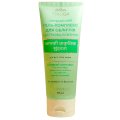 Do you think that dry and dehydrated skin are the same thing? Actually, it is just a common misconception. Today, we’re going to tell you what exactly the difference between dry and dehydrated skin is and how to take care of your skin in both cases.
Do you think that dry and dehydrated skin are the same thing? Actually, it is just a common misconception. Today, we’re going to tell you what exactly the difference between dry and dehydrated skin is and how to take care of your skin in both cases.
A lot of people think that the terms “dry skin” and “dehydrated skin” are synonymous and interchangeable. In reality, however, this is not the case. Dry skin is a skin type genetically predisposed to insufficient production of sebum (skin oil), while dehydrated skin isn’t a distinct skin type at all; it is a characteristic of the skin that has lost too much moisture.
Naturally dry skin is characterised by reduced barrier functions, since its protective hydro-lipid barrier is very thin or practically non-existent. As a result, dry skin is very vulnerable to various external factors, such as extremely high or low temperatures, dry air, harsh wind, UV radiation, etc. In addition, dry skin easily loses moisture. This skin type is characterised by a constant feeling of tightness, regular flaking, small pores, a dull complexion, and proneness to irritation.
Dehydration can occur to any skin type, be it dry, oily, or even normal. As a rule, dehydrated skin looks dull and rough, and can have a yellowish tint to it. Wrinkles and other signs of skin ageing are more pronounced on dehydrated skin. Many people with dehydrated skin experience increased skin sensitivity, which usually results in redness, itching, and flaking.
Unfortunately, you can do nothing to change your genetically predetermined skin type. If you have naturally dry skin, you’re stuck with it for the rest of your life. Dehydrated skin, on the other hand, is a temporary condition. If you take proper care of it, you will restore its moisture levels in no time. Then again, taking proper care of dry skin won’t change its type, but it will make it look and feel healthy.
How to Take Care of Dry Skin?
In this case, the main task of your skincare routine is to restore and maintain the hydro-lipid barrier of the skin. For this purpose, you should use skincare products that contain emollients – moisturising ingredients that soften the skin. Common emollients used in skincare products for dry skin include shea butter and other vegetable oils, ceramides, and squalene (squalane). These ingredients help to reinforce the skin’s protective barrier and prevent flaking, redness, and irritation.
How to Take Care of Dehydrated Skin?
What dehydrated skin needs most is powerful hydration. Therefore, it is important to use skin moisturisers that are formulated with humectants – ingredients that can draw moisture from the surrounding air and lock it in the skin. Common humectants include, for example, hyaluronic acid, glycerine, urea (carbamide), aloe vera, honey, alpha hydroxy acids, and some peptides.
How to Take Care of Dry and Dehydrated Skin?
Naturally dry skin that is also dehydrated needs super intensive care. Moisturising products for dry and dehydrated skin should contain all three types of moisturising ingredients: emollients, humectants, and occlusives. Occlusive ingredients create an invisible protective layer on the skin surface to prevent dehydration. Cosmetic ingredients with occlusive properties include mineral oil, petroleum jelly, lanolin, beeswax, plant waxes, dimethicone and other silicones.
Dry and dehydrated skin have similar symptoms and often go hand in hand. But you should also remember that other skin types can suffer from a lack of moisture too, so hydration should be a part of your skincare routine regardless of your skin type. To make sure your skin is always hydrated, you should not only regularly apply moisturiser, but also drink enough water during the day to provide your skin with moisture from the inside.
Moisturising Skincare Products in Our Store
Triuga Ayurveda Mix Extra Moisturising Face Gel for All Skin Types, 75 ml |
Triuga Ayurveda Mix Extra Moisturising Face Serum 35+, 50 ml |
